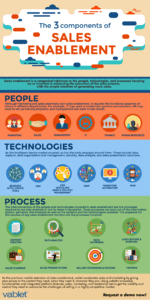According to researchers, sales enablement emerged because enterprises began to identify it as a role, system, or function within their organizations. However, it is important to note that sales enablement is also considered a broad concept because it implicates elements of nearly every business function within an enterprise.
This rapid conceptualization may be out of the necessity to categorize certain enterprise functions, which are not a-typical business functions at all. One thought is that we are trying to minimize the vagueness or confusion by organizing this new trend into a meaningful category.
Based on our experience, sales enablement is a categorical reference to the people, technologies, and processes focusing on or involved in enhancing the execution of the sales process, with the simple intention of generating more sales.
Companies typically look at leveraging sales enablement technologies when they are struggling to stay competitive in their markets or they simply want to close more sales. They are looking for a solution to help their sales and marketing teams be more effective, more productive, and align to one another. Moreover, they want to gain insight or analytic details from their sales activities. They no longer want to be blind to what is happening in the field.
Some of the issues encountered were the desire to easily control content used by sales reps in the field as well as the branding and messaging of the materials presented in client-facing sales meetings. They also want to leverage the innovation; beauty and flexibility of rich media file types such as PDFs, videos, and HTML5. They want to build customized training and sales tools as well as digitally recreate commonly used forms. They want to have these tools in one place, to be available in any environment, on or offline. In addition, they wanted to capture the details of these client meetings and integrate that data back into their CRM or ERP solutions.
